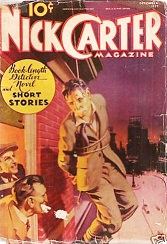
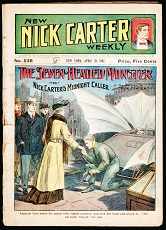 Nick Carter, Master Detective aired “The Case of the Candidate’s Corpse” on September 26, 1948. We have run but five previous Nick Carter episodes out of over 350 since we began this OTR feature in 2009, and it has been quite some time since the last one. Realizing that we have new listeners finding us each week, I am copying below the original introductory material I wrote for that first episode some 5 years ago in 2011, followed by story notes for this specific episode, which I chose because of its political setting which, in this summer of 2016 and the runup to the Presidential election in November, is proving to be one of the most bizarre political silly seasons in memory.
Nick Carter, Master Detective aired “The Case of the Candidate’s Corpse” on September 26, 1948. We have run but five previous Nick Carter episodes out of over 350 since we began this OTR feature in 2009, and it has been quite some time since the last one. Realizing that we have new listeners finding us each week, I am copying below the original introductory material I wrote for that first episode some 5 years ago in 2011, followed by story notes for this specific episode, which I chose because of its political setting which, in this summer of 2016 and the runup to the Presidential election in November, is proving to be one of the most bizarre political silly seasons in memory.
(Cover at left: December 1935 – Cover at right: April 20, 1907)
Nick Carter on radio ran a respectable twelve years, from 1943-1955, but the famous detective’s history begins much earlier. During the post-Civil War era known as Reconstruction, a short story featuring Carter appeared in an obscure fiction paper (The New York Weekly) in 1886 (predating the first Sherlock Holmes story by two years). The publisher was none other than Street & Smith, a fledgling, struggling publishing firm which would later become the most dominant pulp magazine publisher in the world. Among its later titles would be Astounding Science Fiction (now Analog), the only magazine from Street & Smith to survive the pulp magazine crash of the 1950s.
Award-winning radio historian Elizabeth McLeod notes that, “Within a decade, an ongoing series of Nick Carter novels vaulted [Street & Smith] to the front ranks of dime-novel publishers, and made Nick himself a national institution. Nick’s own magazine, The New Nick Carter Weekly, would carry the detective into the twentieth-century.” By 1915, however, the then titled Nick Carter Weekly became Street and Smith’s Detective Story Magazine, a true pulp magazine and S&S’s initial entry into this new format. Again, from Elizabeth McLeod: “Detective Story Weekly soon became Street and Smith’s flagship publication. With the rise of radio in the 1920s, it became the firm’s entree into the broadcast medium. The Street and Smith Detective Story Hour became a favorite of listeners at decade’s end, with elaborate tales of murder and crime hosted by a mysterious narrator introduced only as “The Shadow.” While Nick Carter himself did not appear on the program, his spirit was very much in evidence in the various detective characters that populated the stories.” Of course, we all know what happened next. The mysterious voice only introducing the S&S Detective Story Hour became so popular that S&S launched The Shadow magazine in 1931, and shortly thereafter S&S added Doc Savage to its pulp adventure line. Amidst all of this activity Nick Carter was even given his own magazine (again) in 1933, proving the character’s resiliency and staying power–he was now 47 years old.

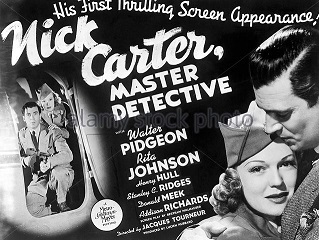 Nick Carter Magazine ran for 40 issues, from March 1933 to June 1936, the final six issues slightly retitled as Nick Carter Detective Magazine. While the magazine had folded, its long-running character still lived, for in 1939 Hollywood picked up the movie rights and produced three “B” Carter films starring noted actor Walter Pidgeon (who later would star in the classic 1956 SF film Forbidden Planet). A mere three years later, Nick Carter would rise from the dead yet again in his own radio series, Nick Carter, Master Detective. The show’s producer and often the writer, Sherman “Jock” MacGregor, would enlist some of the best writers in the business to script Carter’s episodes, including Robert Arthur and David Kogan of Mysterious Traveler fame, the creator of The Shadow, Walter Gibson, and none other than legendary SF author Alfred Bester (one of which Bester-written episodes, “Chemical Chickens,” we ran in March of 2014 here). Lon Clark played Nick Carter throughout its 12-year run, ably supported by first Helen Choate and then Charlotte Manson as Nick’s intelligent, perky secretary Patsy Bowen. Other mainstay characters included Police Sergeant Matty Mathieson, young newspaper reporter Scubby Wilson, and scruffy old veteran of the crime game Waldo McGlynn. (Photo above right: Helen Choate and Lon Clark.)
Nick Carter Magazine ran for 40 issues, from March 1933 to June 1936, the final six issues slightly retitled as Nick Carter Detective Magazine. While the magazine had folded, its long-running character still lived, for in 1939 Hollywood picked up the movie rights and produced three “B” Carter films starring noted actor Walter Pidgeon (who later would star in the classic 1956 SF film Forbidden Planet). A mere three years later, Nick Carter would rise from the dead yet again in his own radio series, Nick Carter, Master Detective. The show’s producer and often the writer, Sherman “Jock” MacGregor, would enlist some of the best writers in the business to script Carter’s episodes, including Robert Arthur and David Kogan of Mysterious Traveler fame, the creator of The Shadow, Walter Gibson, and none other than legendary SF author Alfred Bester (one of which Bester-written episodes, “Chemical Chickens,” we ran in March of 2014 here). Lon Clark played Nick Carter throughout its 12-year run, ably supported by first Helen Choate and then Charlotte Manson as Nick’s intelligent, perky secretary Patsy Bowen. Other mainstay characters included Police Sergeant Matty Mathieson, young newspaper reporter Scubby Wilson, and scruffy old veteran of the crime game Waldo McGlynn. (Photo above right: Helen Choate and Lon Clark.)
From Nick Carter’s beginnings in 1886 through his final radio show in 1955, Carter would change with the times; from clean-living detective, master of disguise, to anti-espionage agent, to the bane of mad scientists or the defender of scientists beset by crooks, Nick Carter has enjoyed one of the longest surviving, most popular runs in various media for over 100 years, for when his radio show ended in 1955 he would resurface (yet again!) in a series of James Bond-type paperback novels in the 1960s which ran into the 1990s.
Virtually forgotten today, Nick Carter predates Dashiell Hammett’s Sam Spade, Raymond Chandler’s Philip Marlowe, and was originally inspired by the real-life exploits of private investigator Allan Pinkerton. In this episode, a pompous, puffed-up, self-entitled politician seeks Nick’s help in stopping a threat against him during his run for re-election. The politician (as if politics wasn’t a circus in itself) has brought in a carnival as a publicity stunt to draw crowds during one of his appearances, but it seems he has brought in serious trouble as well. There’s murder, an Oriental dancing girl who figures prominently, and plenty of scheming and deception to go around. A perfect episode for this Presidential election year, which may turn out to be the silliest season of them all.
Play Time: 27:38
{While the neighborhood gang we have been following for several years now undoubtedly made their routine trip to the corner newsstand in September of 1948 and chose the latest issues of their favorite SF magazines, we can only speculate that if we were to follow them 20-30 years into the future–to the 1970s and 80s–that at least some of them would still be reading the SF magazines. We are also given to wonder how many of them, now fully adult, might remember listening to Nick Carter on the radio in the 1940s and early 1950s, and wonder what became of him. They would find that their beloved Nick Carter had continued to evolve as he had for over 100 years, this time as a spy, as the rather tawdry novels showcased below (known for their action, adventure, and detailed sexual encounters–and which sold copies into the many millions) were following yet another current trend. Picked up and thumbed through at a local used bookstore bargain bin, we have a hunch that at least one of our former neighborhood pulp SF magazine fans might just purchase one, purely for old times sake. But which one would it be?}
A final note of some interest is that there were some 250+ Nick Carter spy novels written from 1964-1990, “Nick Carter” being the house name under which the novels were written. Wikipedia provides more detail and tells us that: “None of the Nick Carter series of books carried author credits, although it is known that several of the earliest volumes were written by Michael Avallone, while Valerie Moolman and NYT bestselling author Gayle Lynds wrote others, making this the first series of its kind to be (significantly) written by women. Bill Crider is another author identified with Nick Carter.”
[Left: Six Bloody Summer Days, 1971 – Center: The Dubrovnik Massacre, 1981 – Right: The Solar Menace, 1981]
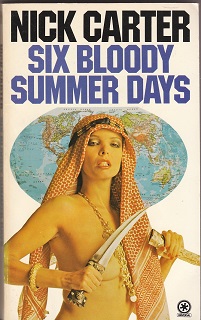
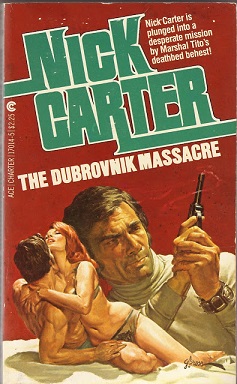
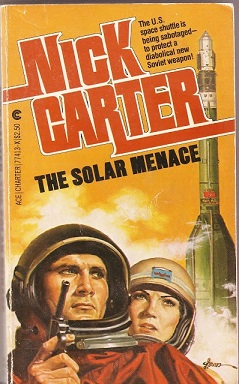
To view the entire list of weekly Old Time Radio episodes at Tangent Online, click here.